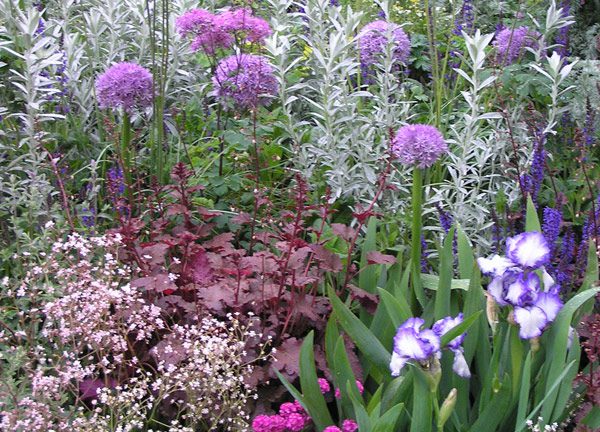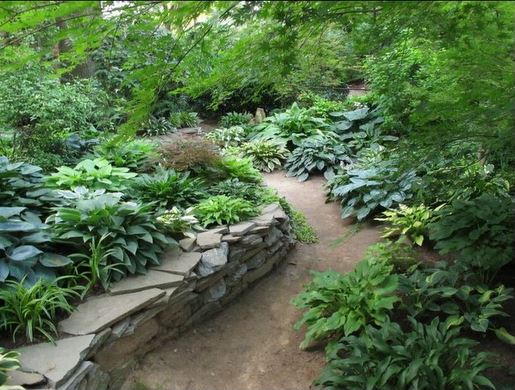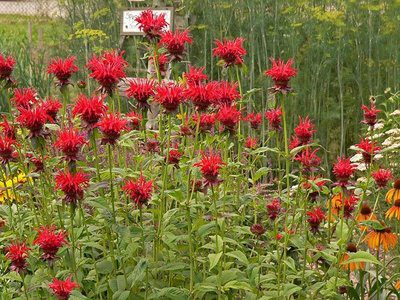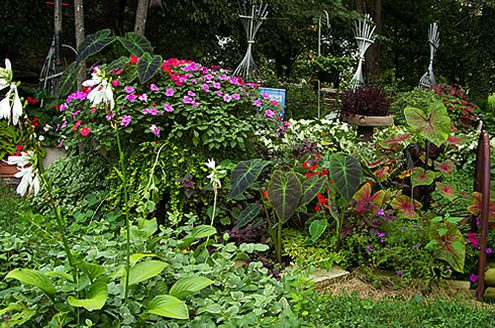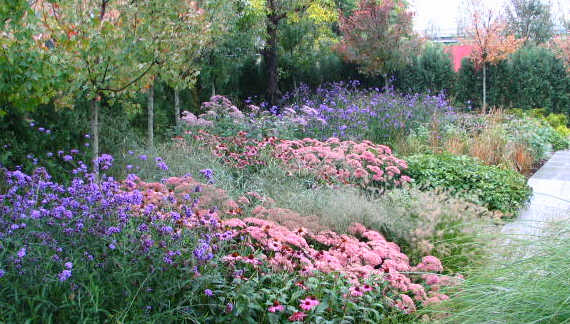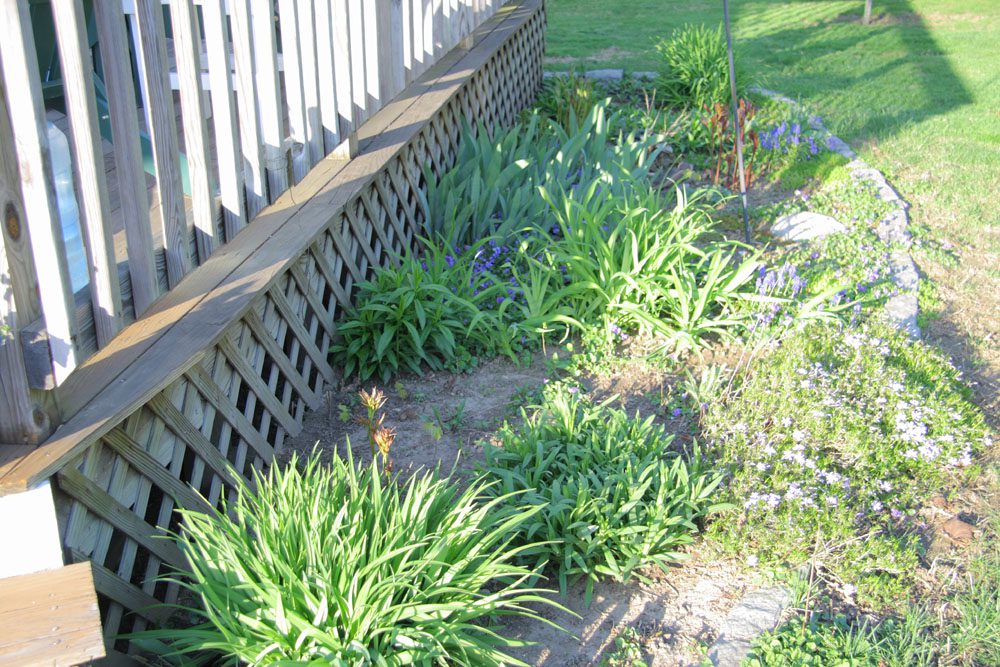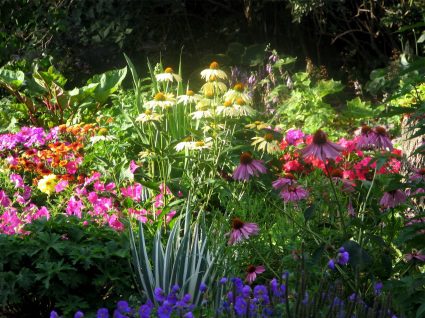 Sit back and enjoy for years to come!
Sit back and enjoy for years to come!
A perennial garden is an investment in your future happiness, believe it or not. If you could sit back and reflect on all the hours you’ve spent planting annuals over the years, how much time do you think was wasted? Maybe not wasted, but perhaps, better applied in other ways.
Lets Get Planning!
Alright, our knees are dirty, our beds are cut and soil all ready to be dug into, but where to begin?
Lets start with a game plan!
First: Think back good and hard, is that location good and hot and sunny or is it shady? This is going to make a huge impact into your plant selections.
This is where color schemes come into play, almost like using a paint brush to color the mood of your landscape.
Got The Blues?
If you’ve determined your area is hot and sunny, do you want to emphasize that aspect, or do you want to cool it down a little bit? Its amazing what mood you can create just by using different selection of flowers.
If your looking to cool down your hot sunny location, pastels in whites blues and purples create a soothing, calming effect. These colors resemble cool water and crisp whites cool down even the hottest areas. These color schemes are incredibly useful for back yard areas, creating a cool spot in an otherwise bland, perhaps non landscaped yard.
These color schemes are also very suitable for areas where perhaps existing landscape is present, due to the fact that the cool hues tend not to clash against other colors as much as say, orange, would.
Cool Color Schemes in the Sun:
- Saliva ‘May Night’, ‘Caradonna’
- Russain Sage varieties
- Caryopteris varieties
- Shasta Daisy ‘Snowcap
- Phlox ‘Eva Cullum’ or ‘David’
- Nepeta ‘Walkers Low’
- Daylily ‘Joan Senior’
- Lavenders and Rosemary
- Agapanthus
- Candytuft ‘Purity’
- Artemesia
If you are looking to create the same effect, but in a shady location, you’re in luck. There are many plants that will still fit into your color scheme and be happy in the shade. Although the list isn’t quite as long, there are still some excellent options.
Cool Color Schemes in the Shade:
- Blue Leaved Hostas such as ‘Blue Angel’ and ‘Mouse Ears’
- Painted Japanese Fern
- Woodland Phlox
- Lenten Roses
- Lily Of The Valley
- Snow On the Mountain
- Astilbe ‘Duetchland’
- Columbine varieties
- Spiderwort Varieties
Pastels aren’t for everyone, this is for certain! Many people like a little more whiz bang action and excitement in their garden.
Hot Stuff Are We?
If vibrant yellows and flashy reds are more your speed, this is where you must take a moment and ponder how flashy you really want to get. The flashier the better is applicable in most cases, but not so in a perennial garden. If you start incorporating too many hot colors into one concentrated area, it becomes confusing and chaotic to the eye. You should chose two hot colors to go with and stick to them. Hot colors include reds, yellows, oranges, vibrant pinks, chartreuse leaves and other variegation.
In a small setting, sticking with yellows is a more prudent practice to keep your design looking clean and kept, whereas in larger areas, using bright reds creates a sense of depth and structure.
Hot plants For Sunny Areas:
- Lantana ‘Miss Huff’ or ‘Chapel Hill’
- Stella de Oro daylilys
- Galliardia varieties
- Coreopsis varieties
- Salvia ‘Hot Lips’
- Pineapple Sage (a staff favorite)
- Emerald and Gold
- Taylorstown Red Verbena
- Lobelia ‘Cardinal Red’
- Monarda ‘Fireball’ or ‘Jacob Kline’
- Black Eyed Susan
- Sedum Varieties
Shady spot? No problem, we can achieve the same “Hot” color scheme in your darkest corner as well. The plant selection isn’t quite as large as in the sunshine, but never fear, it will still have the same wow factor. Caution should be used in the shade though, and mass planting is a recommended with this color sheme in the shade. Instead of doing a large assortment, or a one of everything approach, stick to two or three and group large areas of the same plant together. For example, plant five instead of three of a certain hosta, or six instead of three of a columbine. It just makes it look better, trust me, I am a professional.
Hot Plants for Shade:
- Hosta ‘Sum and Substance’ or ‘August Moon’ (staff favorite)
- Astilbe varieties such as ‘Fanal’ or ‘Garnat’ (yes, its spelled right)
- Columbine varieties
- Heuchera ‘Key Lime Pie’
- Trandencatia ‘Little Kate’
- Autumn Fern
Again, the list isn’t huge for shady hot plants, this is where you can trick the eye by using non plant material to give your garden that extra wow factor. As in the picture above, to create more interest and color, a red chair was added to an otherwise boring perennial bed. Other things can be used as well such as old washboards, fence sections or even an old wheelbarrow!
Annuals, beautiful and glamorous, have a spot in the perennial garden too, but as an accent not a main attraction. A fancy glazed pot or iron urn with a blooming annual can make a great accompaniment to your perennial garden. Also, to break up the monotony of plants, a nice hardgood addition such as a birdbath or statue can really bring a pop of color that lasts all season long! Replacing one or two areas of annual a year isn’t all that bad, and really, it gives you an opportunity to create a different look from year to year.
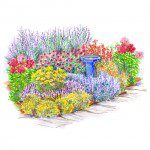 Say you have a pot in your perennial garden and one year you decide that you want to go all hot pink, the next year you can turn the sails and go in a totally different direction, without spending a ton of money or wasting a lot of energy. Its as easy as plopping in an annual or two. A change in a small splash of color can bring a new character to your perennial bed, without digging anything up!
Say you have a pot in your perennial garden and one year you decide that you want to go all hot pink, the next year you can turn the sails and go in a totally different direction, without spending a ton of money or wasting a lot of energy. Its as easy as plopping in an annual or two. A change in a small splash of color can bring a new character to your perennial bed, without digging anything up!
Starting from scratch, might have been a bit scary at first, but no fear, baby steps! We’re here to help you out! A suggestion would be to print out the lists and come in and see for yourself. What looks good on paper may not excite you in person and what excites you in person might alter your whole plan.
After selection is made of your plant materials, caution of placement of the plant material is crucial. What you must do is figure out what you want to be the “Main Event”, usually this is the plant that you like the most and want to accent. After that is selected, plop him in the middle and build out around him, making sure you pay careful attention to what sizes and shapes you are dealing with. Of course, you want the taller plants to be located towards the back and have ground covers to the front (that seems a little elementary, but it bears saying anyways).
Most importantly, you need to make sure you have TEXTURES! All plants are going to look like weeds if you don’t have some rhyme or reason to your design. Make sure when selecting plant you grab some with different foliage attributes such as strap like leaves of daylilies placed next to broad leaves of a monarda. Try not to pair similar flower shapes together either, such as daisy like flower on top of other daisy like flowers. Doing this will create interest and make harmony among your flowers.
Good:
Notice the attention to colors and textures. The eye is constantly going from one flower to the next, it doesn’t get bored looking at one particular plant or color.
Bad:
Care was taken in selecting a color scheme, but it looks like the local nursery had a sale on grassy type things and weedy type blue flowers. Awful. Don’t let THIS happen to YOU.
Enough of this, get planting already!
You can do it, now you know how!


